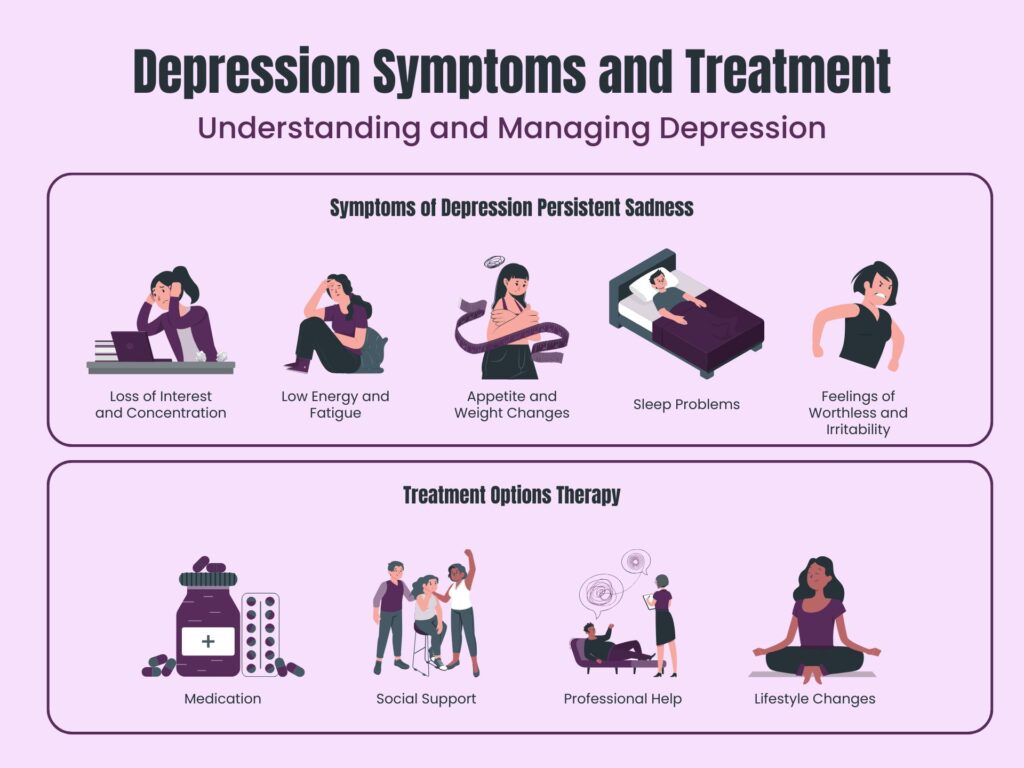Understanding Depression: Types, Symptoms, and Treatment
Depression is a complex mental health disorder that can profoundly impair a person’s thoughts, feelings, and ability to function. Depression affects millions of people globally, with varying intensity, duration, and causes. Understanding the different types of depression and recognizing the signs can assist those in need in seeking appropriate care and assistance.

What Is Depression?
Depression is a mood condition marked by persistent sorrow, hopelessness, and a loss of interest in formerly pleasurable activities. Unlike transitory sadness, depression disrupts daily life, relationships, and employment.
Common Symptoms of Depression
While the symptoms can differ among individuals, the following are common:
- Persistent sadness or dark mood
- Feelings of worthlessness or hopelessness
- Appetite or weight change
- Sleep disorders (excessive or insufficient)
- Fatigue and loss of energy
- Difficulty concentrating and making decisions
- Withdrawing from social engagements.
- A decline in enthusiasm for pastimes or pursuits
- Thoughts of death, self-harm, or suicide
If these symptoms last longer than two weeks and interfere with daily functioning, they could be signs of clinical depression.
Exploring the Different Types of Depression
Depression comes in a variety of forms, each with its own particular characteristics. Here’s an overview of the most common types:
1. Major Depressive Disorder (MDD)
MDD, also referred to as clinical depression, is typified by intense symptoms that persist for at least two weeks.
Symptoms include:
- Continuous anguish and despair.
- Sleep disorders.
- Fatigue and loss of energy might lead to trouble concentrating.
- Loss of Interest in Activities
- Suicidal ideation
MDD affects everyone, regardless of their life situation. Treatment usually consists of both therapy and medication.
2. Persistent Depressive Disorder (PDD)
PDD, formerly called dysthymia, is a type of depression that lasts for two years or longer. Although the symptoms are less severe than those of MDD, they are persistent and can have an impact on daily life.
Symptoms include:
- Feelings of profound grief or despair
- Low self-esteem
- Lack of interest in activities.
- Sleep or appetite changes
- difficulty concentrating
PDD may feel like a permanent state of being, thus therapy is required to improve quality of life.
3. Bipolar Disorder (Manic Depression)
Significant mood fluctuations alternating between manic (high-energy) and depressive (low-energy) episodes are the hallmarks of bipolar disorder.
Signs of Mania:
- High energy levels and a reduced need for sleep.
- Rapid ideas and speech
- Risky habits.
Signs of Depression: - Profound grief or despair.
- Fatigue and lack of motivation.
- Suicidal thoughts.
Managing bipolar disorder typically requires mood stabilizers, medication, and ongoing care.
4. Seasonal Affective Disorder (SAD)
The seasonal depression known as SAD typically strikes throughout the fall and winter.
Symptoms include:
- Social withdrawal
- Increased urge for sleep.
- Weight gain
- Persistent sadness
Light treatment and lifestyle adjustments can help to alleviate symptoms.
5. Postpartum Depression (PPD)
PPD develops during or after pregnancy as a result of hormonal changes and childbirth-related pressures.
Symptoms include:
- Extreme grief or despair.
- Difficulty bonding with the baby
- Exhaustion and irritability
- Thoughts of self-harm or harming the baby
If you have thoughts of self-harm or harming your baby, seek immediate help through therapy, support groups, or medication.
6. Premenstrual Dysphoric Disorder (PMDD)
PMDD is a severe version of PMS that predominantly impacts one’s emotional well-being.
Symptoms include:
- Extreme mood swings
- Sadness or hopelessness
- Anxiety and irritation.
- Sleep problems and weariness.
Hormonal treatments and antidepressants may help with PMDD.
7. Atypical Depression
The distinctive feature of this kind of depression is that it momentarily subsides in reaction to happy occasions.
Symptoms include:
- Increased hunger and weight gain.
- Excessive sleep can cause feelings of heaviness in limbs.
- Extreme sensitivity to rejection
Therapy and particular antidepressants are frequently used as treatment options.
8. Situational Depression
This kind, sometimes referred to as adjustment disorder with depression, arises in response to particular life situations, like
- Divorce or relationship issues
- Loss of a loved one
- Financial or legal troubles
Situational depression is usually just brief, yet it can nevertheless interfere with daily life. Therapy and support might help you manage your emotions.
9. Depressive Psychosis
In this extreme form of depression, the typical symptoms are accompanied by delusions or hallucinations.
Symptoms include:
- Sadness or despair
- Delusions or hallucinations
- Physical uneasiness or delayed movement.
Antidepressants and antipsychotic medications are commonly used combined in treatment.
Seeking Help for Depression
If you or someone you know is suffering from depression, it is vital to get treatment from a primary care physician or a mental health specialist. The illness can be diagnosed and treated using therapy, drugs, lifestyle modifications, or a combination of these.
When to Seek Immediate Help
Contact a healthcare provider right away if you have:
- Suicidal ideation
- Severe separation from loved ones.
- Hallucinations or delusions
Takeaway
Although it is a prevalent ailment, depression is treatable. Understanding the various types of depression and its symptoms might help you decide whether it’s time to seek treatment for yourself or a loved one. Despite how overwhelming depression may feel, remember that there is help available and that recovery is achievable.
If you or someone you know is in distress, please contact a mental health professional or a helpline immediately.